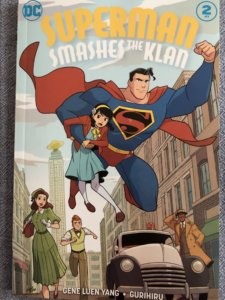Posts Tagged ‘history’
When Science Fiction Brings History Alive
I love science fiction, dreaming about the future, imagining what our life in outer space might look like someday, but my passion for the genre has as much to do with the past as it does with the future. Science fiction shows us the future but also has the ability to teach us about our past and often does so without the baggage of politics and biases. The stories below are launch pads. Their portrayals of history through story are not by any means comprehensive, but rather snapshots into the lives of people encountering challenges that may be imagined by the author, but mirror history.
Here are a handful of scifi stories that bring the reader face to face with the past:
- Superman Smashes the Klan
- The Man in the High Castle
- Colony
- An Excess Male
- Kindred
History Lesson #1. SUPERMAN SMASHES THE KLAN. Launch a discussion about the Ku Klux Klan (it’s inception and impact on US race relations).
In this three-issue Superman Comic, Gene Luen Yang gives historic tidbits at the end of each issue. You can read my review of the series here.
In issue 1,Yang highlights the 13th amendment to the constitution (abolition of slavery) and the 1882 Chinese Exclusion Act
Following issue 2, Yang discusses the Jewish immigrants who created Superman.
Following issue 3, Yang discusses the challenges of his own parents, both of whom were immigrants from Taiwan
History Lesson #2. Watch or read, THE MAN IN THE HIGH CASTLE (book by Philip K. Dick. The Amazon Prime TV series was produced by Dick’s daughter, Isa Dick Hackett). Discuss and learn about World War II.
This series is a great way to understand the Axis powers and that tentative alliance that almost took over the globe. You’ll find yourself or your student understanding the world that was inhabited by those who lived under occupation during that war. The French, The Koreans, and many others were forced to survive under Nazi or Japanese rule. Some made compromises, others rebelled. Can you imagine who you would have become to survive an occupation? That question is a great way for students to enter into and understand history.
History Lesson #3. Watch COLONY on Netflix to begin to grapple with the reality of living under occupation.
In the case of COLONY, the true enemy is an alien race that has invaded Earth, but some of the darkest villains are the human beings who have allied themselves with this conquering force.
Living under occupation, whether under the Greeks, Romans, The Islamic Caliphate, the Brits, the USSR, it requires turncoats, or those who will help to subdue the masses for the sake of the little bits of power and privilege that are doled out by the occupying power. The tv series COLONY does an amazing job of capturing this reality. A longer review can be found here.
History Lesson #4. Read AN EXCESS MALE, by Maggie Shen Chen, to begin to understand 20th century Chinese history.
Although this book imagines a future China, this story highlights what is perhaps the most disastrous public policy mandate of all time, THE ONE CHILD POLICY. For my review of this novel, click here. To read my guide for educators, click here.
History Lesson #5. KINDRED, by Octavia Butler. Read this book (fictional) and one of the other historic slave narratives like, MY LIFE AS A SLAVE, by Frederick Douglass. Discuss the ways slavery dehumanizes all those who participate in its reality.
KINDRED, by the late and great Octavia Butler, gives the reader a taste of the slave-inhabited South of yore. The brutality is evident and palpable. Lessons are brought so close…it’s hard to read this book, yet it is valuable for those trying to understand slavery in 18th and 19th century US. Here is my longer review of Kindred




